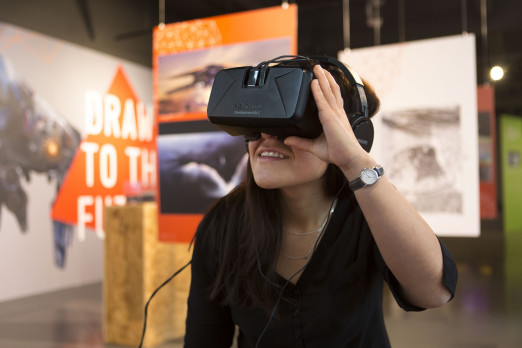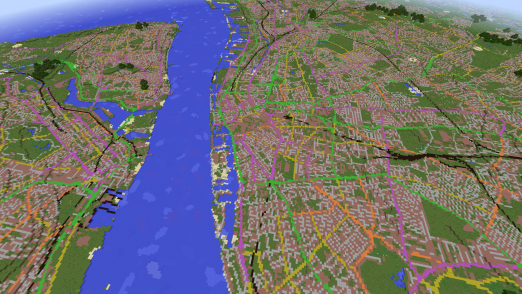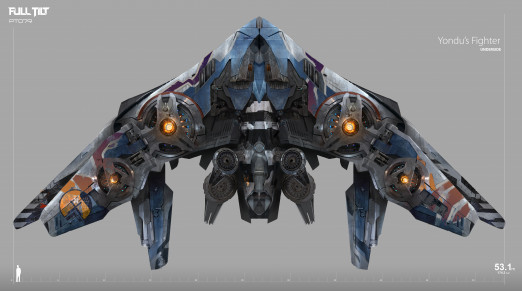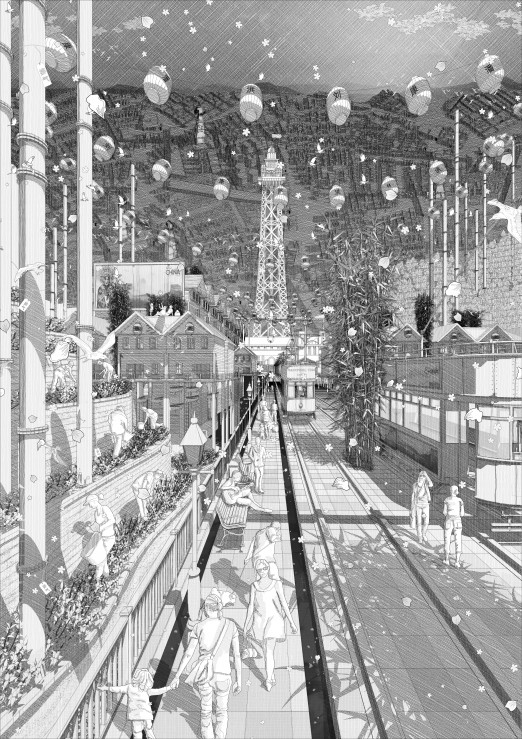The old and the new
Frackpool by Jason Lamb, The Bartlett School of Architecture
3D model and hand-sketched elements with pencil hatch. Finished on 315gsm Fourdrinier-made cartridge paper with vellum surface. Originally produced at 1372mm x 1016mm.
Frackpool combines the power of line illustration to engage the imagination with more traditional architectural drawing. This graduation project by Bartlett School of Architecture student Jason Lamb attracted international coverage for its richly worked vision of a future Blackpool, transformed by the wealth and industrial implications of fracking. New industries and complex sustainable water systems are envisaged, as heavy Chinese investment steers the urban regeneration. Over 80 years, the project speculates the transformation of Blackpool from an industrial Petropolis to a decentralised and less resource-dependent city.
Context
What is your background?
Jason Lamb: I received my Masters in Architecture from The Bartlett School of Architecture, UCL in 2014. I was awarded a Distinction for Design and Thesis and consequentially added to the Dean’s list. My work explores the relationship between narrative, architecture and urbanism. My aim is to objectify topical environmental and social issues using fringe fiction and pose serious questions about the future of the urban environment.
What was the brief and what were the inspirations for this project?
Jason Lamb: The project speculates that Chinese investment prompts the transitory integration of hydraulic fracturing within Blackpool. The project explores the relationship between resource extraction and urban development, in order to extract new templates for sustainable urbanism. The design proposal elucidates not only a vision for water-based urbanism, but speculates on new methodologies for integrating infrastructure, landscape, urban planning and architecture within the scope of contemporary socioeconomic issues currently effecting coastal cities.

(New Pier Construction Urban Agriculture and Water Integration, Frackpool, Jason Lamb)
Who has been an influence on your work in general – not just Frackpool?
Jason Lamb: If I had to choose three… Hariton Pushwagner, Chris Ware, Piranesi.
Research
What types of research did you conduct?
Jason Lamb: Extensive research was conducted in order to complete the project. The research ranged from examining existing comparable infrastructure such as the Oil Boom Towns in Texas, to first-hand social research conducted in Blackpool.
Making
Could you take us through the process of making the image and how long did it take?
Jason Lamb: I start the drawings with an outline sketch, before moving to pencil and trace. Final compositions are an assemblage of large scale pencil hatch drawings which are composed digitally before print on archival fourdrinier-made cartridge paper.
The full series of twelve drawings were drawn over a period of four months. However, the design and technical resolution was prepared over several months before this.
.jpg?1437769578)
(Constructing Bloomfield, Fracking Station 8 of 35, Frackpool, Jason Lamb)
Visual
What kind of training did you get in drawing?
Jason Lamb: I didn’t ever receive any direct training in drawing. However, as a student I was encouraged to explore various methods of representation, and I was taught in detail the craft of composing and framing an image.
How did you settle on number of images?
Jason Lamb: The number of drawings produced was a direct consequence of realizing the project through the narrative and was also limited by the amount of time I had to produce them!
How did you develop the particular visual language mixing western and eastern visual forms?
Jason Lamb: The project speculates that Chinese investment prompts fracking in Blackpool. The visual language is a physical manifestation of this idea. The socioeconomic assumptions are illustrated through the blend of eastern architectural and cultural references with traditional British seaside tectonics.

(Rehousing Communites Constructing Sustainable Offshore Settlements, Frackpool, Jason Lamb)
The images have a strong narrative component, were there any graphic novelists or other sequential artists that informed how you composed and constructed these images?
Jason Lamb: I think that Chris Ware is an incredible artist and he continues to be a huge inspiration to my work.
Futures
There has been quite a transformation in Architectural drawing and image making, how do you see this developing?
Jason Lamb: I think that with recent technological advances, the future of architectural representation looks very interesting. I think we are certainly experiencing a shift in the way in which architectural drawings are represented. However, I believe strongly that hand drawing will always be a vitally important skill to an architect.
Is there space in the profession or a requirement for less digital methods, and perhaps less ‘realism’?
Jason Lamb: I think that a key skill for an architect is the ability to instantly translate an idea on to a physically tangible medium. I believe that speculative architecture is just as important as 'realism'.

(Offshore Communities Rooftop Gardening and Rainwater Collection, Frackpool, Jason Lamb)
Where do you see this kind of scenario work heading?
Jason Lamb: For me, the ability to speculate through drawings is an incredibly important tool to highlight current issues and affairs currently impacting the world. I believe that through this method we can raise awareness, highlight problems and ultimately change the behaviours and the way that people think about urban and social issues.
You can buy prints from Jason Lamb's website here




